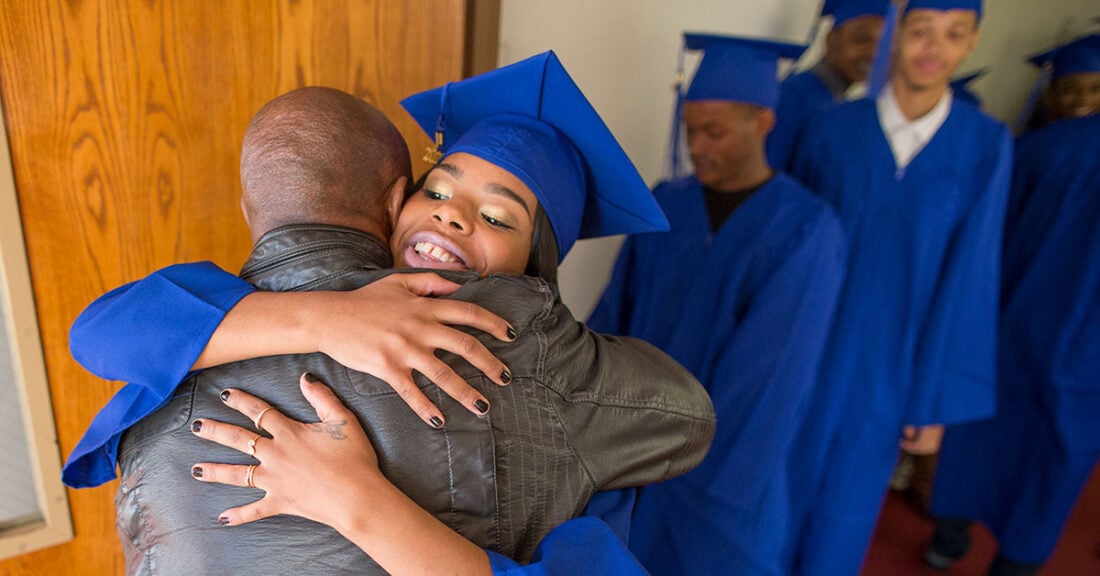Building a Framework to Help Young People Stay on Track for Career Success

Photo credit: Jason E. Miczek for the Casey Foundation
The Annie E. Casey Foundation has teamed up with Johns Hopkins University’s Everyone Graduates Center and community partners in two states to design and implement a new framework to support youth in finishing their education and launching careers.
The framework, called On Track to Career Success (OTCS), will utilize two strategies at once: 1) extending a proven practice for helping ninth graders graduate high school on time; and 2) offering workplace learning experiences that can help all students better prepare for postsecondary education and career success.
During the multi-year project, participating schools and community partners will:
- strengthen school processes to keep all students on track to graduate high school;
- analyze relevant data to uncover gaps, examine root causes of underlying issues and plan ways to address challenges;
- design relevant, culturally responsive and developmentally appropriate opportunities for all students to learn in meaningful ways via work experiences;
- identify, connect and develop postsecondary training and education opportunities; and
- employ evidence-based programs and practices to support students who need it.
OTCS is an example of the Casey Foundation’s Thrive by 25® efforts, which aim to improve the well-being and prospects of young adults ages 14–24.
“High school graduation is an important milestone for young people and their economic prospects,” says Patrice Cromwell, vice president of Casey’s Center for Economic Opportunity. “But a high school diploma is a first step toward college and career. OTCS seeks to ensure that young people are supported by schools and community partners to have the experiences that eventually lead to careers and financial stability.”
Strategies in Action
The project launch is set for two locations — New Orleans, Louisiana, and Albuquerque, New Mexico — at schools that serve many students of color and low-income families.
To start, teacher teams will establish milestones that can be used to help identify ninth graders who are on track to graduate. Factors under consideration will include a student’s transition from eighth grade, attendance, social-emotional development and course grades.
The project will then gradually expand in scope to include students in grades 10 through 12. Teacher teams will again track milestones related to academic progress and social-emotional skills as well as college and career preparations.
“We are trying to create this framework with the folks who do the work,” says Robert Balfanz, director of the Everyone Graduates Center. “If teachers and others are not intimately involved in the creation of the work, it is not going to be sustained.” The team approach in every grade, he says, brings a greater variety of perspectives to the question of whether students are being supported. “Teachers and administrators are responsible for their grade-level milestones, as opposed to just a guidance counselor who is supposed to track everything for every kid,” he says.
Beyond prompting greater collaboration within schools, the framework will also help to connect students in grades 10 through 12 with meaningful career readiness and early work experiences. To achieve this, OTCS will position high schools as community centers and engines for local economic development. The framework calls for schools to develop models of how adding a grade 13 or 14 could help students earn an associate degree or training certification in addition to a high school diploma.
The community partners that will implement OTCS are an intentionally diverse group. They are high schools as well as organizations that manage charter schools, community organizations, workforce development organizations, postsecondary education institutions and more. They also include youth representatives, who will share their thoughts on life as a student and what today’s young people need to realize their goals.
Staying the Course During COVID-19
The COVID-19 pandemic has disrupted the education of young people in significant ways. Across the nation, students are still facing hurdles — including technology divides — that can slow or stop their academic progress. These factors underscore the importance of developing an approach like OTCS to help young people stay on track.
“More than ever,” says Ilene Berman, a senior associate with the Casey Foundation’s Evidence-Based Practice Group, “schools and their community partners need to track and support student connection and engagement and be part of the solution to ensure young people have a plan for success during and after high school.”






